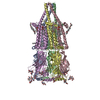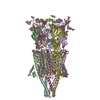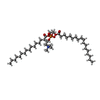[English] 日本語
 Yorodumi
Yorodumi- PDB-8v88: Alpha7-nicotinic acetylcholine receptor bound to epibatidine and ... -
+ Open data
Open data
- Basic information
Basic information
| Entry | Database: PDB / ID: 8v88 | |||||||||||||||||||||||||||||||||||||||||||||||||||||||||||||||||||||||||||||||||||||||||||||||||||
|---|---|---|---|---|---|---|---|---|---|---|---|---|---|---|---|---|---|---|---|---|---|---|---|---|---|---|---|---|---|---|---|---|---|---|---|---|---|---|---|---|---|---|---|---|---|---|---|---|---|---|---|---|---|---|---|---|---|---|---|---|---|---|---|---|---|---|---|---|---|---|---|---|---|---|---|---|---|---|---|---|---|---|---|---|---|---|---|---|---|---|---|---|---|---|---|---|---|---|---|---|
| Title | Alpha7-nicotinic acetylcholine receptor bound to epibatidine and GAT107 | |||||||||||||||||||||||||||||||||||||||||||||||||||||||||||||||||||||||||||||||||||||||||||||||||||
 Components Components | Neuronal acetylcholine receptor subunit alpha-7,Soluble cytochrome b562 | |||||||||||||||||||||||||||||||||||||||||||||||||||||||||||||||||||||||||||||||||||||||||||||||||||
 Keywords Keywords | MEMBRANE PROTEIN / ION CHANNEL / NICOTINIC RECEPTOR | |||||||||||||||||||||||||||||||||||||||||||||||||||||||||||||||||||||||||||||||||||||||||||||||||||
| Function / homology |  Function and homology information Function and homology informationsensory processing / synaptic transmission involved in micturition / dendrite arborization / response to acetylcholine / Highly calcium permeable postsynaptic nicotinic acetylcholine receptors / acetylcholine receptor activity / acetylcholine-gated channel complex / regulation of amyloid fibril formation / acetylcholine-gated monoatomic cation-selective channel activity / short-term memory ...sensory processing / synaptic transmission involved in micturition / dendrite arborization / response to acetylcholine / Highly calcium permeable postsynaptic nicotinic acetylcholine receptors / acetylcholine receptor activity / acetylcholine-gated channel complex / regulation of amyloid fibril formation / acetylcholine-gated monoatomic cation-selective channel activity / short-term memory / cation channel complex / dendritic spine organization / chloride channel regulator activity / acetylcholine binding / regulation of amyloid precursor protein catabolic process / acetylcholine receptor signaling pathway / neurotransmitter receptor complex / positive regulation of amyloid-beta formation / negative regulation of amyloid-beta formation / positive regulation of protein metabolic process / response to amyloid-beta / monoatomic ion channel activity / ligand-gated ion channel signaling pathway / modulation of excitatory postsynaptic potential / plasma membrane raft / negative regulation of tumor necrosis factor production / positive regulation of excitatory postsynaptic potential / toxic substance binding / monoatomic ion transport / negative regulation of canonical NF-kappaB signal transduction / negative regulation of cytokine production involved in inflammatory response / positive regulation of long-term synaptic potentiation / excitatory postsynaptic potential / regulation of membrane potential / response to nicotine / electron transport chain / synapse organization / calcium channel activity / memory / cognition / intracellular calcium ion homeostasis / positive regulation of angiogenesis / calcium ion transport / transmembrane signaling receptor activity / amyloid-beta binding / monoatomic ion transmembrane transport / chemical synaptic transmission / postsynaptic membrane / learning or memory / periplasmic space / response to hypoxia / electron transfer activity / neuron projection / positive regulation of ERK1 and ERK2 cascade / postsynapse / positive regulation of MAPK cascade / iron ion binding / positive regulation of cell population proliferation / heme binding / synapse / dendrite / endoplasmic reticulum membrane / signal transduction / protein homodimerization activity / membrane / plasma membrane Similarity search - Function | |||||||||||||||||||||||||||||||||||||||||||||||||||||||||||||||||||||||||||||||||||||||||||||||||||
| Biological species |  Homo sapiens (human) Homo sapiens (human) | |||||||||||||||||||||||||||||||||||||||||||||||||||||||||||||||||||||||||||||||||||||||||||||||||||
| Method | ELECTRON MICROSCOPY / single particle reconstruction / cryo EM / Resolution: 2.3 Å | |||||||||||||||||||||||||||||||||||||||||||||||||||||||||||||||||||||||||||||||||||||||||||||||||||
 Authors Authors | Burke, S.M. / Noviello, C.M. / Hibbs, R.E. | |||||||||||||||||||||||||||||||||||||||||||||||||||||||||||||||||||||||||||||||||||||||||||||||||||
| Funding support |  United States, 1items United States, 1items
| |||||||||||||||||||||||||||||||||||||||||||||||||||||||||||||||||||||||||||||||||||||||||||||||||||
 Citation Citation |  Journal: Cell / Year: 2024 Journal: Cell / Year: 2024Title: Structural mechanisms of α7 nicotinic receptor allosteric modulation and activation. Authors: Sean M Burke / Mariia Avstrikova / Colleen M Noviello / Nuriya Mukhtasimova / Jean-Pierre Changeux / Ganesh A Thakur / Steven M Sine / Marco Cecchini / Ryan E Hibbs /   Abstract: The α7 nicotinic acetylcholine receptor is a pentameric ligand-gated ion channel that plays an important role in cholinergic signaling throughout the nervous system. Its unique physiological ...The α7 nicotinic acetylcholine receptor is a pentameric ligand-gated ion channel that plays an important role in cholinergic signaling throughout the nervous system. Its unique physiological characteristics and implications in neurological disorders and inflammation make it a promising but challenging therapeutic target. Positive allosteric modulators overcome limitations of traditional α7 agonists, but their potentiation mechanisms remain unclear. Here, we present high-resolution structures of α7-modulator complexes, revealing partially overlapping binding sites but varying conformational states. Structure-guided functional and computational tests suggest that differences in modulator activity arise from the stable rotation of a channel gating residue out of the pore. We extend the study using a time-resolved cryoelectron microscopy (cryo-EM) approach to reveal asymmetric state transitions for this homomeric channel and also find that a modulator with allosteric agonist activity exploits a distinct channel-gating mechanism. These results define mechanisms of α7 allosteric modulation and activation with implications across the pentameric receptor superfamily. | |||||||||||||||||||||||||||||||||||||||||||||||||||||||||||||||||||||||||||||||||||||||||||||||||||
| History |
|
- Structure visualization
Structure visualization
| Structure viewer | Molecule:  Molmil Molmil Jmol/JSmol Jmol/JSmol |
|---|
- Downloads & links
Downloads & links
- Download
Download
| PDBx/mmCIF format |  8v88.cif.gz 8v88.cif.gz | 726.6 KB | Display |  PDBx/mmCIF format PDBx/mmCIF format |
|---|---|---|---|---|
| PDB format |  pdb8v88.ent.gz pdb8v88.ent.gz | 617.5 KB | Display |  PDB format PDB format |
| PDBx/mmJSON format |  8v88.json.gz 8v88.json.gz | Tree view |  PDBx/mmJSON format PDBx/mmJSON format | |
| Others |  Other downloads Other downloads |
-Validation report
| Summary document |  8v88_validation.pdf.gz 8v88_validation.pdf.gz | 2.5 MB | Display |  wwPDB validaton report wwPDB validaton report |
|---|---|---|---|---|
| Full document |  8v88_full_validation.pdf.gz 8v88_full_validation.pdf.gz | 2.5 MB | Display | |
| Data in XML |  8v88_validation.xml.gz 8v88_validation.xml.gz | 47.6 KB | Display | |
| Data in CIF |  8v88_validation.cif.gz 8v88_validation.cif.gz | 63.5 KB | Display | |
| Arichive directory |  https://data.pdbj.org/pub/pdb/validation_reports/v8/8v88 https://data.pdbj.org/pub/pdb/validation_reports/v8/8v88 ftp://data.pdbj.org/pub/pdb/validation_reports/v8/8v88 ftp://data.pdbj.org/pub/pdb/validation_reports/v8/8v88 | HTTPS FTP |
-Related structure data
| Related structure data |  43030MC  8ut1C  8utbC  8uzjC  8v80C  8v82C  8v86C  8v89C  8v8aC  8v8cC  8v8dC C: citing same article ( M: map data used to model this data |
|---|---|
| Similar structure data | Similarity search - Function & homology  F&H Search F&H Search |
- Links
Links
- Assembly
Assembly
| Deposited unit | 
|
|---|---|
| 1 |
|
- Components
Components
-Protein , 1 types, 5 molecules ABCDE
| #1: Protein | Mass: 67220.797 Da / Num. of mol.: 5 Source method: isolated from a genetically manipulated source Details: 351-353 (linker) 354-460 (SOLUBLE CYTOCHROME B562 FUSION) 551-558 (strep tag II) 559-571 (linker) 572-579 (strep tag II) 580-582 (linker) 583-599 (T2A self cleaving peptide post cleavage) ...Details: 351-353 (linker) 354-460 (SOLUBLE CYTOCHROME B562 FUSION) 551-558 (strep tag II) 559-571 (linker) 572-579 (strep tag II) 580-582 (linker) 583-599 (T2A self cleaving peptide post cleavage),351-353 (linker) 354-460 (SOLUBLE CYTOCHROME B562 FUSION) 551-558 (strep tag II) 559-571 (linker) 572-579 (strep tag II) 580-582 (linker) 583-599 (T2A self cleaving peptide post cleavage),351-353 (linker) 354-460 (SOLUBLE CYTOCHROME B562 FUSION) 551-558 (strep tag II) 559-571 (linker) 572-579 (strep tag II) 580-582 (linker) 583-599 (T2A self cleaving peptide post cleavage) Source: (gene. exp.)  Homo sapiens (human) / Gene: CHRNA7, NACHRA7, cybC / Production host: Homo sapiens (human) / Gene: CHRNA7, NACHRA7, cybC / Production host:  Homo sapiens (human) / References: UniProt: P36544, UniProt: P0ABE7 Homo sapiens (human) / References: UniProt: P36544, UniProt: P0ABE7 |
|---|
-Sugars , 3 types, 15 molecules 
| #2: Polysaccharide | 2-acetamido-2-deoxy-beta-D-glucopyranose-(1-4)-2-acetamido-2-deoxy-beta-D-glucopyranose Source method: isolated from a genetically manipulated source #3: Polysaccharide | beta-D-mannopyranose-(1-4)-2-acetamido-2-deoxy-beta-D-glucopyranose-(1-4)-2-acetamido-2-deoxy-beta- ...beta-D-mannopyranose-(1-4)-2-acetamido-2-deoxy-beta-D-glucopyranose-(1-4)-2-acetamido-2-deoxy-beta-D-glucopyranose Source method: isolated from a genetically manipulated source #5: Sugar | ChemComp-NAG / |
|---|
-Non-polymers , 6 types, 130 molecules 








| #4: Chemical | ChemComp-CA / #6: Chemical | ChemComp-POV / ( #7: Chemical | ChemComp-9Z9 / ( #8: Chemical | ChemComp-EPJ / #9: Chemical | ChemComp-YLI / ( Mass: 405.309 Da / Num. of mol.: 5 / Source method: obtained synthetically / Formula: C18H17BrN2O2S / Feature type: SUBJECT OF INVESTIGATION #10: Water | ChemComp-HOH / | |
|---|
-Details
| Has ligand of interest | Y |
|---|---|
| Has protein modification | Y |
-Experimental details
-Experiment
| Experiment | Method: ELECTRON MICROSCOPY |
|---|---|
| EM experiment | Aggregation state: PARTICLE / 3D reconstruction method: single particle reconstruction |
- Sample preparation
Sample preparation
| Component | Name: Alpha7-nicotinic acetylcholine receptor bound to epibatidine and GAT107 Type: COMPLEX / Entity ID: #1 / Source: RECOMBINANT |
|---|---|
| Source (natural) | Organism:  Homo sapiens (human) Homo sapiens (human) |
| Source (recombinant) | Organism:  Homo sapiens (human) Homo sapiens (human) |
| Buffer solution | pH: 7.4 |
| Specimen | Conc.: 7.5 mg/ml / Embedding applied: NO / Shadowing applied: NO / Staining applied: NO / Vitrification applied: YES |
| Vitrification | Cryogen name: ETHANE |
- Electron microscopy imaging
Electron microscopy imaging
| Experimental equipment |  Model: Titan Krios / Image courtesy: FEI Company |
|---|---|
| Microscopy | Model: FEI TITAN KRIOS |
| Electron gun | Electron source:  FIELD EMISSION GUN / Accelerating voltage: 300 kV / Illumination mode: FLOOD BEAM FIELD EMISSION GUN / Accelerating voltage: 300 kV / Illumination mode: FLOOD BEAM |
| Electron lens | Mode: BRIGHT FIELD / Nominal defocus max: 2000 nm / Nominal defocus min: 700 nm |
| Image recording | Electron dose: 44 e/Å2 / Film or detector model: GATAN K3 (6k x 4k) |
- Processing
Processing
| EM software |
| ||||||||||||||||||||||||
|---|---|---|---|---|---|---|---|---|---|---|---|---|---|---|---|---|---|---|---|---|---|---|---|---|---|
| CTF correction | Type: PHASE FLIPPING AND AMPLITUDE CORRECTION | ||||||||||||||||||||||||
| Symmetry | Point symmetry: C5 (5 fold cyclic) | ||||||||||||||||||||||||
| 3D reconstruction | Resolution: 2.3 Å / Resolution method: FSC 0.143 CUT-OFF / Num. of particles: 316844 / Symmetry type: POINT | ||||||||||||||||||||||||
| Refine LS restraints |
|
 Movie
Movie Controller
Controller












 PDBj
PDBj












